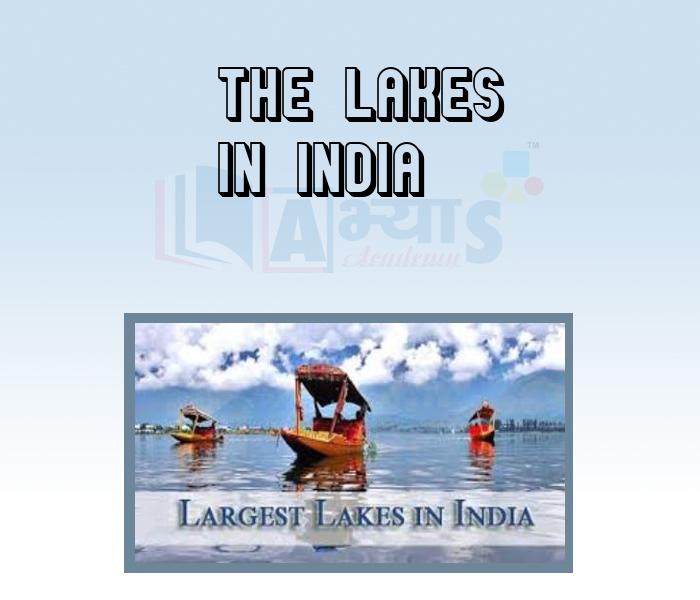The Lakes in India













The Lakes in India
LAKES: Lakes are useful to human beings in many ways. Dal Lake in Kashmir valley is an attractive tourist destination famous for its house boats and shikaras. Other than tourism, lakes are also used for sporting activities like boating, swimming, water sports, etc.Lakes in India: India has many lakes. These differ from each other in their size and other characteristics. There are permanent as well as seasonal lakes. Seasonal lakes contain water only during the monsoon season, e.g. the lakes found in the inland drainage basins of semi-arid regions, i.e. the SÄmbhar salt lake in Rajasthan. (Its water is used to produce salt).Lakes in India are formed by different processes. e.g. some are formed by the action of glaciers and ice sheets, while the others have been found by wind, river actions or human activities.A meandering river across a flood plain forms cut-offs that later develop into Ox-bow lakes. Spits and bars form lagoons in coastal areas, e.g. the Chilika, Pulicat and Kolleru lakes.Fresh Water LakesFresh water lakes are formed when glaciers dig out a basin, which is later filled with snowmelt. Most of the fresh water lakes are in the Himalayan region, being formed by the action of glaciers.The Wular lake in Jammu and Kashmir is the result of tectonic activity. Wular lake is the largest fresh water lake in India.The Dal lake, Nainital, Bhimtal, Loktak and Barapani are some other important fresh water lakes.Apart from natural lakes, the damming of the rivers for the generation of hydel power has also led to the formation of lakes such as Guru Gobind Sagar (Bhakra Nangal Project) formed by damming the Satluj.Importance of LakesLakes are of great value to human beings. A lake helps to regulate the flow of a river.During heavy rainfall, it prevents flooding and during the dry season, it helps to maintain an even flow of water.It can also be used for developing hydel power. It moderates the climate of the surroundings, maintain the aquatic ecosystem, enhance natural beauty, helps develop tourism and provide recreation.71 per cent of the world’s surface is covered with water, but 97 per cent of that is salt water. Of the 3 per cent that is available as freshwater, three quarters of it is trapped as ice.Lakes of large extent are called the seas, like the Caspian, the Dead and the Aral seas.The role of rivers in the economy is stated in the points below(i) Rivers provide water for irrigation.(ii) They provide facility for navigation.(iii) They provide water for domestic use like washing, cooking, drinking, etc.(iv) They help to generate hydroelectric power.(v) The river banks have attracted settlers from ancient times and these settlements have now become big cities.(vi) They help to moderate the climate of the surrounding area. (vii) They help to promote fisheries.
Which is the deepest lake of the World? | |||
| Right Option : C | |||
| View Explanation | |||
Students / Parents Reviews [10]
Being a parent, I saw my daughter improvement in her studies by seeing a good result in all day to day compititive exam TMO, NSO, IEO etc and as well as studies. I have got a fruitful result from my daughter.

Prisha Gupta
8thAbout Abhyas metholodology the teachers are very nice and hardworking toward students.The Centre Head Mrs Anu Sethi is also a brilliant teacher.Abhyas has taught me how to overcome problems and has always taken my doubts and suppoeted me.

Shreya Shrivastava
8thI have spent a wonderful time in Abhyas academy. It has made my reasoning more apt, English more stronger and Maths an interesting subject for me. It has given me a habbit of self studying

Yatharthi Sharma
10thAbhyas is a complete education Institute. Here extreme care is taken by teacher with the help of regular exam. Extra classes also conducted by the institute, if the student is weak.

Om Umang
10thIt was a good experience with Abhyas Academy. I even faced problems in starting but slowly and steadily overcomed. Especially reasoning classes helped me a lot.

Cheshta
10thAbhyas Methodology is very good. It is based on according to student and each child manages accordingly to its properly. Methodology has improved the abilities of students to shine them in future.

Manish Kumar
10thMy experience with Abhyas is very good. I have learnt many things here like vedic maths and reasoning also. Teachers here first take our doubts and then there are assignments to verify our weak points.

Shivam Rana
7thMy experience with Abhyas academy is very good. I did not think that my every subject coming here will be so strong. The main thing is that the online tests had made me learn here more things.

Hiya Gupta
8thIt has a great methodology. Students here can get analysis to their test quickly.We can learn easily through PPTs and the testing methods are good. We know that where we have to practice

Barkha Arora
10thMy experience was very good with Abhyas academy. I am studying here from 6th class and I am satisfied by its results in my life. I improved a lot here ahead of school syllabus.
